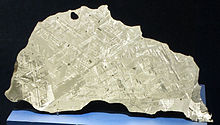Gibeon (meteorite)
| Gibeon | |
|---|---|
 Gibeon meteorites in Post Street Mall,Windhoek | |
| Type | Iron |
| Structural classification | Fineoctahedrite |
| Group | IVA[1] |
| Composition | 91,8%Fe;7,7%Ni;0,5%Co;0,04%P;2,4 ppmIr;1,97 ppmGa;0,111 ppmGe |
| Country | Namibia |
| Region | Great Namaqualand |
| Coordinates | 25°20′S18°00′E/ 25.333°S 18.000°E |
| Observed fall | No |
| Fall date | prehistorictimes |
| Found date | 1838[1] |
| TKW | 26000 kg[1] |
| Strewn field | Yes |
 Widmanstätten pattern | |
Gibeonis ameteoritethat fell inprehistorictimes inNamibia.It was named after the nearest town:Gibeon.
History
[edit]The meteorite was discovered by theNama peopleand used by them to make tools and weapons, including heads for theirassegais.[2]
In 1836[1]the English captain J. E. Alexander collected samples of the meteorite in the vicinity of theFish Riverand sent them to London. ThereJohn Herschelanalyzed them and confirmed for the first time the extraterrestrial nature of the material.
Between 1911 and 1913, 33 fragments of the meteorite were collected in the vicinity of Gibeon and brought to the capitalWindhoek.They weighed between 195 and 506 kilograms (430 and 1,116 lb) and were first stored, then displayed at theZoo Parkas a single heap. In 1975 a public fountain displaying the meteorite fragments was planned. The pieces were removed and stored at theAlte Feste,where two of the fragments were stolen. The fountain was eventually erected in Post Street Mall, with two empty pillars for the missing fragments. Since then, two more fragments were removed from the fountain, so that it displays only 29 pieces today.[3]
The collection displayed on the fountain inWindhoek's Central Business Districtwas proclaimed a National Monument (Category: geology) on 15 February 1950. Additionally, it was decided that all meteorites found in Namibia would automatically be protected as National Monuments and should not be removed from where they have been found, nor damaged in any way.[3]
Strewn field
[edit]The fragments of the meteorite in thestrewn fieldwere dispersed over an elliptical area 390 kilometres (240 mi) long and 120 kilometres (75 mi) wide, the second largest known strewn field in the world (afterAletai meteoritestrewn field in Northwestern China).[2][4]The core of this area is situated near the village ofGibeonin Namibia'sHardap Region.About 100–150 different fragments have been collected over time, and additional pieces are still[update]found occasionally.[3]
Composition and classification
[edit]The term Gibeon encompasses the total extent of meteoritic material fallen from the sky during this fall. This material is classified asiron meteoritebelonging to the chemical group IVA.[1]
Gibeon meteorites are composed of aniron-nickelalloy containing significant amounts ofcobaltandphosphorus.The crystal structure of this meteorite provides a classic example of fineoctahedriteand theWidmanstätten patternis appreciated for its beauty both by collectors and designers of jewelry.
See also
[edit]References
[edit]- ^abcdeMeteoritical Bulletin Database:Gibeon
- ^abBuchwald, Vagn F. (1975).Handbook of Iron Meteorites, Volume 2 (Gerzeh - Glorieta Mountain).University of California Press. pp.584–593.ISBN0520029348.
- ^abcVoigt, Andreas (2004).National Monuments in Namibia: An Inventory of Proclaimed National Monuments in the Republic of Namibia.Gamsberg Macmillan. pp.1–3.ISBN9991605932.
- ^Li, Ye; et al. (24 June 2022)."A unique stone skipping–like trajectory of asteroid Aletai".Science Advances.8(25).doi:10.1126/sciadv.abm8890.PMC9232108.Retrieved2024-09-04.


